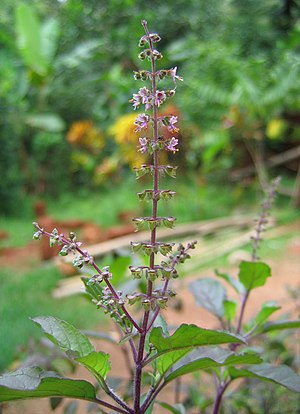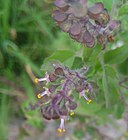Note: This is a project under development. The articles on this wiki are just being initiated and broadly incomplete. You can Help creating new pages.
Ocimum tenuiflorum - Tulsi plant
Tulsi is a scared plant in Hindu belief. Hindus regarding it as an earthy manifestation of the goddess Tulsi, she is regarded as a great worshipper of the god Vishnu. The plant is cultivated for religious and medical purposes, and for its essential oil.
Uses
Fever, Common cold, Sore throat, Headache, Eye problems, Dental problem, Skin disorder, Insect bites, Kidney stone.
Food
Ocimum tenuiflorum can be used in Food. Leaves are used in preparation of tea and seeds are eaten raw.[1]
Parts Used
Chemical Composition
It contains Carvacrol, caryophyllene, eugenol, linalool, urosolic acid.[2]
Common names
| Language | Common name |
|---|---|
| Kannada | Krishna Tulasi |
| Hindi | Tulsi |
| Malayalam | NA |
| Tamil | Tolasi |
| Telugu | Tulasi |
| Marathi | NA |
| Gujarathi | NA |
| Punjabi | NA |
| Kashmiri | NA |
| Sanskrit | Tulasi |
| English | Holy Basil |
Properties
Reference: Dravya - Substance, Rasa - Taste, Guna - Qualities, Veerya - Potency, Vipaka - Post-digesion effect, Karma - Pharmacological activity, Prabhava - Therepeutics.
Dravya
Rasa
Tikta (Bitter), Kashaya (Astringent)
Guna
Laghu (Light), Ruksha (Dry), Tikshna (Sharp)
Veerya
Ushna (Hot)
Vipaka
Katu (Pungent)
Karma
Kapha, Vata
Prabhava
Nutritional components
Ocimum tenuiflorum Contains the Following nutritional components like - Vitamin-A (carotene), C; Eugenol, B-caryophyllene, Sesquiterpenes monoterpenes; Calcium, Iron, Magnesium, Manganese, Phosphorus, Potassium, Sodium, Zinc.[1]
Habit
Identification
Leaf
| Kind | Shape | Feature |
|---|---|---|
| Simple | Opposite | Leaves 1.3- 3 x 0.6-2 cm, elliptic-oblanceolate, obtuse at both ends, margin coarsely serrate, puberulous; petiole to 2 cm long, covered with reddish-purple hairs |
Flower
| Type | Size | Color and composition | Stamen | More information |
|---|---|---|---|---|
| Bisexual | Raceme | Pink/white | 4 | Racemes to 11 cm long, generally simple, occasionally branched at base; pedicel c. 2 mm long. Flowering throughout the year |
Fruit
| Type | Size | Mass | Appearance | Seeds | More information |
|---|---|---|---|---|---|
| Nutlet | 1.5 mm long | Ellipsoid, dark brown | Fruiting throughout the year |
Other features
List of Ayurvedic medicine in which the herb is used
Where to get the saplings
Mode of Propagation
How to plant/cultivate
A plant of the moist to wet, lowland tropics, where it is found at elevations up to 1,000 metres. Can be easily grown from seed[5]. Ocimum tenuiflorum is available through September to February[1].
Commonly seen growing in areas
Photo Gallery
References
- ↑ 1.0 1.1 1.2 "Forest food for Northern region of Western Ghats" by Dr. Mandar N. Datar and Dr. Anuradha S. Upadhye, Page No.120, Published by Maharashtra Association for the Cultivation of Science (MACS) Agharkar Research Institute, Gopal Ganesh Agarkar Road, Pune
- ↑ Chemical constituents
- ↑ Kappatagudda - A Repertoire of Medicianal Plants of Gadag by Yashpal Kshirasagar and Sonal Vrishni, Page No. 284
- ↑ Ayurvedic preparations
- ↑ Cultivation details
External Links
- Ayurvedic Herbs known to be helpful to treat Fever
- Ayurvedic Herbs known to be helpful to treat Common cold
- Ayurvedic Herbs known to be helpful to treat Sore throat
- Ayurvedic Herbs known to be helpful to treat Headache
- Ayurvedic Herbs known to be helpful to treat Eye problems
- Ayurvedic Herbs known to be helpful to treat Dental problem
- Ayurvedic Herbs known to be helpful to treat Skin disorder
- Ayurvedic Herbs known to be helpful to treat Insect bites
- Ayurvedic Herbs known to be helpful to treat Kidney stone
- Herbs with Flowers used in medicine
- Herbs with Leaves used in medicine
- Herbs with common name in Kannada
- Herbs with common name in Hindi
- Herbs with common name in Tamil
- Herbs with common name in Telugu
- Herbs with common name in Sanskrit
- Herbs with common name in English
- Habit - Herb
- Index of Plants which can be propagated by Seeds
- Index of Plants which can be propagated by Cuttings
- Herbs that are commonly seen in the region of Tropical area
- Herbs that are commonly seen in the region of Subtropical area
- Herbs that are commonly seen in the region of Warm fields
- Herbs
- Ayurvedic herbs that don't have seed photos
- Lamiaceae



